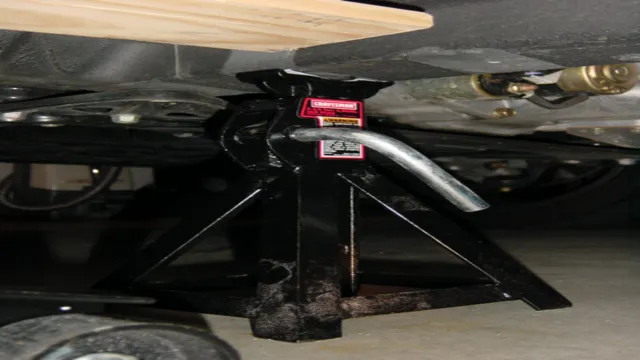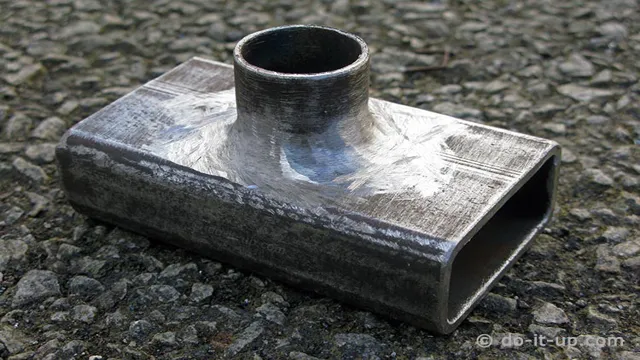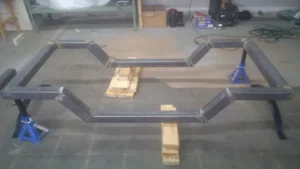Are you in the process of performing some maintenance or repair work on your vehicle and need to lift the rear end using Jack Stands? If yes, then you are in the right place. When it comes to jacking up vehicles, most people are aware of the significant risks involved. However, if the process is done right, you can easily create a safe and secure workspace that will ensure that you get the job done without any accidents.
In this post, we’ll talk about what you need to know before using Jack Stands on the Rear Axle, including the dos and don’ts that will ensure your safety. We’ll take you through the process step-by-step, giving you all the information you need to know so that you can lift your vehicle with confidence and accuracy. Jacking up your car is the first step towards safe and secure maintenance or repair work underneath your vehicle.
When it comes to raising your car’s rear end, there are some things you need to keep in mind to avoid accidents and potential injuries. By following a few basic steps and precautions, you can ensure your safety and the safety of your car. So, are you ready to learn how to safely use Jack Stands on the Rear Axle? Let’s get started!
Introduction
If you’re wondering whether it’s safe to place jack stands on the rear axle of your vehicle, the answer is yes, but it depends on several factors. First and foremost, you need to make sure that your vehicle’s owner’s manual allows for this method of jacking up the car. Some cars may have specific lifting points designated for jack stands.
Secondly, you’ll want to make sure that the rear axle is strong enough to support the weight of the vehicle when it’s lifted off the ground. If you’re unsure about the strength of the rear axle, it’s probably best to err on the side of caution and use different jacking points. Additionally, when using jack stands on the rear axle, make sure that they’re placed securely and evenly to prevent the car from toppling over.
With these considerations in mind, you can safely lift your car by the rear axle and perform necessary maintenance tasks without worry.
Why You Might Choose Jack Stands on the Rear Axle
Jack Stands on the Rear Axle

Risks of Jack Stands on the Rear Axle
When it comes to lifting a vehicle, jack stands are essential tools to ensure safety. However, there are risks to be aware of, particularly when using them on the rear axle. When raising the rear end of a vehicle using jack stands, it’s crucial to ensure that the vehicle is level.
Otherwise, the jack stands can slip, causing significant damage or injury. Furthermore, it’s crucial to ensure that the jack stands are placed on a stable surface that can support the weight of the vehicle. Neglecting these precautions can result in the jack stands giving way, causing the car to topple off of the stands.
It’s also vital to avoid placing the jack stands on any suspension components or brake lines as they can break or crack when weight is placed on them. By adhering to these precautions, the risks of using jack stands on the rear axle can be mitigated, resulting in a safe and successful lift.
When and How to Use Jack Stands on the Rear Axle
It is possible to put jack stands on the rear axle, but it’s important to make sure you do it correctly to avoid any accidents. Before attempting to use jack stands on the rear axle, make sure you have the proper tools and equipment, including a sturdy pair of jack stands and a hydraulic jack. Once you have these items, find a flat surface, raise the vehicle with the hydraulic jack, and then carefully place the jack stands under the rear axle.
Make sure to position the jack stands on a solid and level surface, and ensure they are positioned correctly. Once the jack stands are securely in place, you can safely work on the vehicle without worrying about it falling or moving. Remember to always follow safety guidelines and use common sense when working on any vehicle.
By using jack stands correctly, you can keep yourself and your vehicle safe while working on it.
Preparation and Safety
When working on a vehicle, ensuring proper safety is crucial. A key element of this is using jack stands on the rear axle when necessary. But how do you know when it’s needed and how should you go about it? First things first, always follow the manufacturer’s instructions for your specific vehicle when lifting and supporting it.
Generally, you’ll need to locate the rear axle’s jack points, which can usually be found in your car’s manual. Once you’ve safely positioned your vehicle’s jack, it’s time to lift the rear axle. It’s important to never trust the jack alone to hold up your car – this is where jack stands come in.
Simply slide the stands under the proper jack points on the rear axle, adjust the height as needed, and double-check everything is secure before working on your car. Remember, always take your time and double-check everything before getting under a lifted vehicle. The last thing you want is to risk your safety or that of anyone else by taking shortcuts or rushing through the process.
It’s better to be cautious and confident than to take unnecessary risks.
Step-by-Step Guide to Installing Jack Stands on the Rear Axle
Using jack stands on the rear axle of your vehicle is a critical step in securing your car safely while you work underneath it. Before attempting any repair or maintenance tasks on your vehicle, it’s important to lift your car only by the designated lift points, avoiding any vulnerable areas that could damage your car or cause an accident. When it comes to using jack stands on the rear axle, you need to make sure your vehicle is in park or neutral, and the emergency brake is engaged.
Then, locate the rear axle and position your jack stand near the axle so it can support the car. Once you’ve placed the jack stand in the correct position, slowly lower your vehicle until it’s resting securely on the stand. Remember to follow the manufacturer’s instructions and always use high-quality jack stands that can hold the weight of your vehicle safely.
By following these guidelines, you can work with confidence, avoid accidents, and ensure the safety of yourself and your car.
Tips for Proper Alignment and Stability
When it comes to proper alignment and stability of your vehicle, using jack stands on the rear axle can be extremely helpful. But when should you use them, and how should you go about it? First and foremost, it’s important to note that jack stands should only be used on a flat, level surface. Once you’ve determined that the surface is safe and stable, place the stands at the proper height on either side of the rear axle.
To ensure stability, it’s important to use the appropriate jack stand weight capacity for your vehicle. This information can be found in your owner’s manual or by consulting a trusted mechanic. Once the jack stands are in place, use your jack to lift the vehicle off the ground and securely onto the stands.
It’s crucial to make sure the vehicle is centered and balanced before doing any work. Whether you’re performing routine maintenance or undertaking a major repair, using jack stands on the rear axle can help keep your vehicle stable and reduce the risk of injury. Just remember to take the necessary precautions and never rush through the process.
With patience and care, you can safely and confidently work under your vehicle with the help of jack stands.
Alternatives to Jack Stands on the Rear Axle
Yes, you can put jack stands on the rear axle, but there are alternative methods that you can use if you are not comfortable with this option. One of the best alternatives is to use vehicle ramps. These ramps are easy to use, and they allow you to work on your car without having to raise it up too much.
Another option is to use a lift. While lifts can be expensive, they are very effective, and they allow you to work on your car without having to worry about stability or balance. Finally, you could use axle stands.
These stands are specially designed to support the weight of your car, and they are perfect for supporting the rear axle. No matter which option you choose, it is important to follow safety guidelines and always make sure that your car is properly supported before you start working on it.
Other Types of Jack Stands and Their Benefits
If you’re looking for alternatives to using jack stands on the rear axle of your vehicle, there are several options worth considering. One such option is using ramps. Ramps can be a convenient alternative because they’re easy to use and don’t require a lot of effort to set up.
Plus, they’re lightweight and can be stored easily. Another type of jack stand alternative is a scissor jack. Scissor jacks are great for smaller cars and can be inexpensive to purchase.
They’re durable and compact, and they’re also easy to use, making them a great choice for those who don’t have a lot of experience with automotive DIY projects. Ultimately, the best alternative for you will depend on what type of vehicle you have and what you’re comfortable using. Consider your needs and budget, and do some research into the various options available to make sure you’re making the right choice.
Using a Lift Instead of Jack Stands on the Rear Axle
If you are looking for alternatives to jack stands on the rear axle of your vehicle, a lift can be a great option. Lifts are easy to use and provide a safe and secure way to elevate your vehicle off the ground. They are available in a range of sizes and styles, allowing you to choose a lift that is suited to your needs.
Whether you are working on your car at home or running a garage, a lift is a versatile and practical tool that can help you get the job done quickly and efficiently. With the right lift, you can easily inspect the undercarriage of your car, change the oil, or perform other routine maintenance tasks with ease. So why struggle with the hassle of jack stands when you can use a lift instead?
Conclusion
In conclusion, while it may seem like a convenient option to put jack stands on the rear axle, it’s important to remember that safety should always come first. You wouldn’t want to risk damaging your vehicle or even worse, injuring yourself. So let’s stick to the tried and true method of using jack stands on the designated lift points – after all, it’s better to be safe than axle-less.
“
FAQs
How do I safely put my vehicle on jack stands?
It is recommended to use jack stands on proper support points such as the frame rather than the axle. However, if it is necessary to put them on the rear axle, make sure the stands are sturdy and rated for the weight of your vehicle.
Can I put jack stands on the rear axle of my truck?
Yes, you can put jack stands on the rear axle of your truck, but it is safer to use them on the frame or support points designed by the manufacturer.
Can I use a jack stand on only one side of the vehicle?
It is not recommended to use only one jack stand as it can cause the vehicle to tip over. Always use two stands on both sides of the vehicle.
Can I use a hydraulic jack to lift my vehicle?
Yes, a hydraulic jack can be used to lift your vehicle but be sure to use jack stands for support before working under the vehicle.
How do I know what weight rating jack stands to use?
The weight rating of the jack stands should be higher than the weight of your vehicle. The weight of your vehicle can be found in the owner’s manual or on the driver’s side door jamb.
How long can I leave my vehicle on jack stands?
It is not recommended to leave a vehicle on jack stands for an extended period of time. Always use these stands for lifting your vehicle and remove them when the work is done.
Is it necessary to chock the wheels when using jack stands?
Yes, it is recommended to chock the wheels when using jack stands for additional safety and to prevent the vehicle from rolling.






